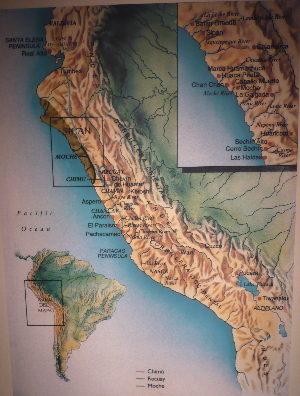 What an epic day. Lying in bed late yesterday evening, reading myself to sleep, I noticed the bed suddenly wobbling strangely, I thought maybe it was a tremor – nothing as alarming as an earthquake – then maybe just a couple in the room next door having a rather good time. Then it was over before I could really work it out, and I forgot about it. Today, however, it was the small talk of the day amongst the Chiclayo guides and drivers who took me around to the tourist sites in my itinerary
What an epic day. Lying in bed late yesterday evening, reading myself to sleep, I noticed the bed suddenly wobbling strangely, I thought maybe it was a tremor – nothing as alarming as an earthquake – then maybe just a couple in the room next door having a rather good time. Then it was over before I could really work it out, and I forgot about it. Today, however, it was the small talk of the day amongst the Chiclayo guides and drivers who took me around to the tourist sites in my itinerary
today. It was a mini-earthquake; the first in quite some time, especially noticeable for someone, like me, on the sixth floor of my hotel. The joys of being so close to a continental plate subduction zone!
Anyway – up early to get breakfast in before meeting my guide for the
day at 8.45am, we headed straight off to the Tucume complex, a
Lambayeque (also known as Sican) site to the north of Chiclayo.
Following the Cupisnique culture 800-200BCE on the far north coast, the
Piera-based Vicus culture 1000BCE-300CE and the Moche civilisation
1-800CE over the whole of northern Peru, the Lambayeque/Sican culture
750-1375CE, contemporary with the Chimu in the southern half of northern
Peru, covered the northern half of what had been the Moche
civilisation. Facial reconstruction from royal skulls, along with
distinctive ceramic and architectural styles, set them apart from both
their Moche forebears, and their Chimu 900-1470CE neighbours, whose
culture represented more of a development from the earlier Moche. Both
were later taken over by the pan-Andean Inca’s, shortly before the
arrival of the Spanish. The only surviving written records of any
pre-Columbian cultures are of course, like Roman accounts of the Celts,
written by the Spanish conquerors, but include a monk’s retelling of the
Lambayeque origin myth, which claims that their first God-King arrived
from the sea, with a fleet. Thor Heyerdahl’s Kon-Tiki expedition proved
the practical possibility of the Lambayeque having originated from a
Polynesian invasion. Contemporary with the third stage of the
Lambayeque culture another group of Polynesians of course arrived in New
Zealand, establishing the Maori, and populating the islands for the
first time. Even if, after the manner of Francis Pryor’s anti-invasion
historical stance, this Polynesian invasion of northern Peru was little
more than a Norman-style invasion by a new ruling elite, it is still a
compelling theory. Mochica, the language of the Moche, was spoken all
over the north right up until the last Mochica speaker died 25 years
ago, and there is no record of any specific Lambayeque language.
The Tucume complex is from the third stage of the Lambayeque/Sican
culture, with its own distinctive style of ceramics. The first and
second stages, 750-900CE, and 900-1100CE, were characterised by a dark
grey ceramic style (the colour came from the smoke of the firing
process) that, at least in the second stage, was mainly focussed on
representations of their God-Kings. The second stage ended during a La
Nina – the 20-30year dry period that appears erratically in opposition
to the more common El Nino
wet periods that bring floods every half-decade or so to the Peruvian
coast. The 2nd stage Sican culture – and their 30 or more pyramids –
ended in flames, and they moved to Tucume, where a third stage Sican
culture 1100-1375CE, built another 26 new pyramids, but were no longer
led by God-Kings.
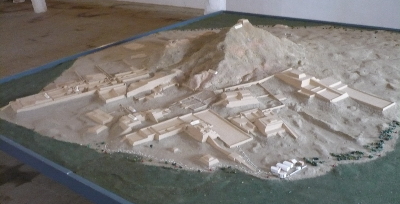
Tucume is a vast site – a complex of 26 mud-brick pyramids –
clustered around an isolated pyramidal hill. The pre-columbian peruvian
pyramid is not like the Egyptian pyramid; in the north here,
especially. Here in the north they were made of mud-brick, and with wide
flat tops that act as platforms for royalty and priesthood to live on,
with all their various entourages. The largest of the pyramids here at
Tucume is the largest pyramid in the Americas. They have all suffered
somewhat from the last 1000 years of rain, but for mud-brick it is
remarkable how much has actually survived!
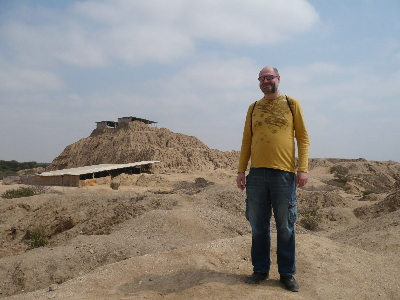
Further south the last museum of the day showcases the remains of two of
the Lords of the Sican/Lambayeque culture – from the second stage
900-1100CE, prior to Tucume.
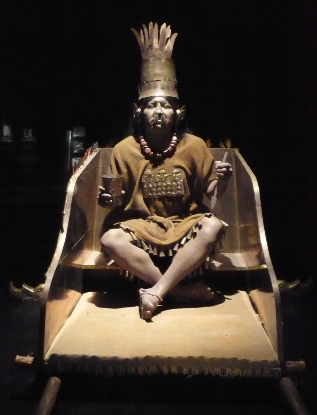
But by far the most amazing visit of the day has been to the Lords of
Sipan museum in the town of Lambayeque. Sipan, a pyramid site up to the
north east of the coastal area and unsupported by electricity and other
amenities, was one of the main burial tombs of the Moche kings, and the
museum here in Lambayeque houses two of them – everything from the gold
and silver clothing to their very skeletons, in a magnificent new
building built just like a pyramid. This is probably one of the finest
museums I have ever been to, and although everything was in spanish my
guide interpreted it all in excellent English for me and it was the
highlight of the day. Cameras and mobile phones are not allowed inside,
so I took no pictures. I did however buy the book, and have taken a
couple of snaps for you to get the idea…
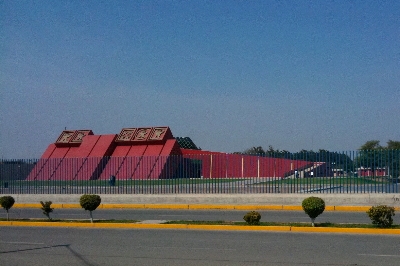
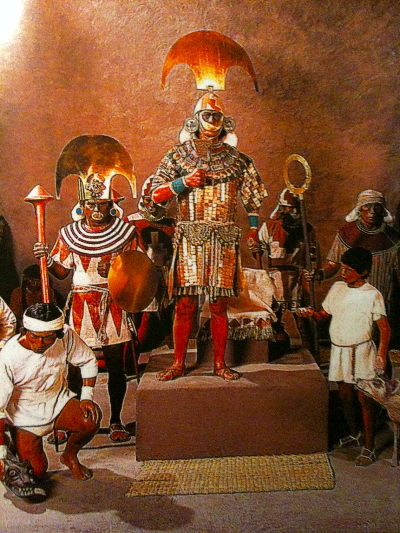
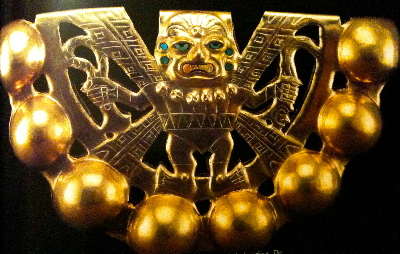
All in all an exhausting day – and time for the local specialty dish: duck and rice; washed down with a Chilean red methinks!
